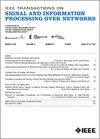通过自适应不确定性感知采样和软分类实现异质噪声下的图信号重构
IF 3
3区 计算机科学
Q2 ENGINEERING, ELECTRICAL & ELECTRONIC
IEEE Transactions on Signal and Information Processing over Networks
Pub Date : 2024-03-11
DOI:10.1109/TSIPN.2024.3375593
引用次数: 0
摘要
从噪声测量子集重建带限图信号是信号处理领域的一项基本挑战。一直以来,这一问题都是在假设整个网络噪声方差一致的情况下解决的。然而,实际场景中经常会出现不同的噪声景观,这就大大增加了信号重建过程的复杂性。本研究探讨了在测量可能受到异质噪声影响的网络中重建图信号的问题。考虑到测量方差中可能存在的特定节点变化,即不同(和未知)的不确定性水平,本研究采用了专为图信号定制的贝叶斯模型。此外,还引入了一种新型的不确定性感知局部图一致性度量,利用估计参数来完善采样过程。通过考虑不确定性,即使在苛刻的噪声条件下,也能提高信号重建的准确性。所提出的方法围绕着一个结合最大似然和最大后验原则的框架。具体来说,每个观测值都根据节点的软分类进行加权,从而将测量可靠性纳入重建过程。后者是通过一种将重新加权迭代最小二乘法与期望最大化相结合的新算法来实现的。这种算法可以有效地管理异质噪声,并具有非局部正则化项的特点,在保持信号不连续性的同时促进重建信号的稀疏性,这对捕捉底层图信号的特征至关重要。大量的仿真证明了所提出的方法在各种图拓扑结构和异常条件下的有效性,显示了与现有方法相比,该方法在信号重构方面的实质性改进。报告还以欧洲哥白尼大气监测服务(CAMS)的 PM10 数据为例进行了说明。本文章由计算机程序翻译,如有差异,请以英文原文为准。
Graph Signal Reconstruction Under Heterogeneous Noise via Adaptive Uncertainty-Aware Sampling and Soft Classification
Reconstructing bandlimited graph signals from a subset of noisy measurements is a fundamental challenge within the realm of signal processing. Historically, this problem has been approached assuming uniform noise variance across the network. Nevertheless, practical scenarios often present heterogeneous noise landscapes, greatly complicating the signal reconstruction process. This study tackles reconstruction of graph signals across networks where measurements may be affected by heterogeneous noise. A Bayesian model tailored for graph signals is employed, considering the potential existence of node-specific variations in measurement variance, namely different (and unknown) levels of uncertainty. Moreover, a novel uncertainty-aware local graph coherence metric is introduced, capitalizing on estimated parameters to refine the sampling process. By accommodating uncertainty, signal reconstruction accuracy is enhanced, even in demanding noise conditions. The proposed approach revolves around a framework combining maximum likelihood and maximum a-posteriori principles. Specifically, each observation is weighted based on a soft classification of nodes, so incorporating measurements reliability into the reconstruction process. The latter is performed through a novel algorithm coupling re-weighted iterative least squares with expectation-maximization. Such an algorithm can effectively manage heterogeneous noise and features a non-local regularization term, which promotes sparsity in the reconstructed signal while preserving signal discontinuities, crucial for capturing the characteristics of the underlying graph signal. Extensive simulations demonstrate the effectiveness of the proposed approach for various graph topologies and anomalous conditions, revealing substantial enhancements in signal reconstruction compared to existing methods. An illustrative example on PM10 data from the European Copernicus Atmosphere Monitoring Service (CAMS) is also reported.
求助全文
通过发布文献求助,成功后即可免费获取论文全文。
去求助
来源期刊

IEEE Transactions on Signal and Information Processing over Networks
Computer Science-Computer Networks and Communications
CiteScore
5.80
自引率
12.50%
发文量
56
期刊介绍:
The IEEE Transactions on Signal and Information Processing over Networks publishes high-quality papers that extend the classical notions of processing of signals defined over vector spaces (e.g. time and space) to processing of signals and information (data) defined over networks, potentially dynamically varying. In signal processing over networks, the topology of the network may define structural relationships in the data, or may constrain processing of the data. Topics include distributed algorithms for filtering, detection, estimation, adaptation and learning, model selection, data fusion, and diffusion or evolution of information over such networks, and applications of distributed signal processing.
 求助内容:
求助内容: 应助结果提醒方式:
应助结果提醒方式:


